Unit 12 Organisational Behaviour
VerifiedAdded on 2023/01/06
|14
|4022
|74
AI Summary
Contribute Materials
Your contribution can guide someone’s learning journey. Share your
documents today.
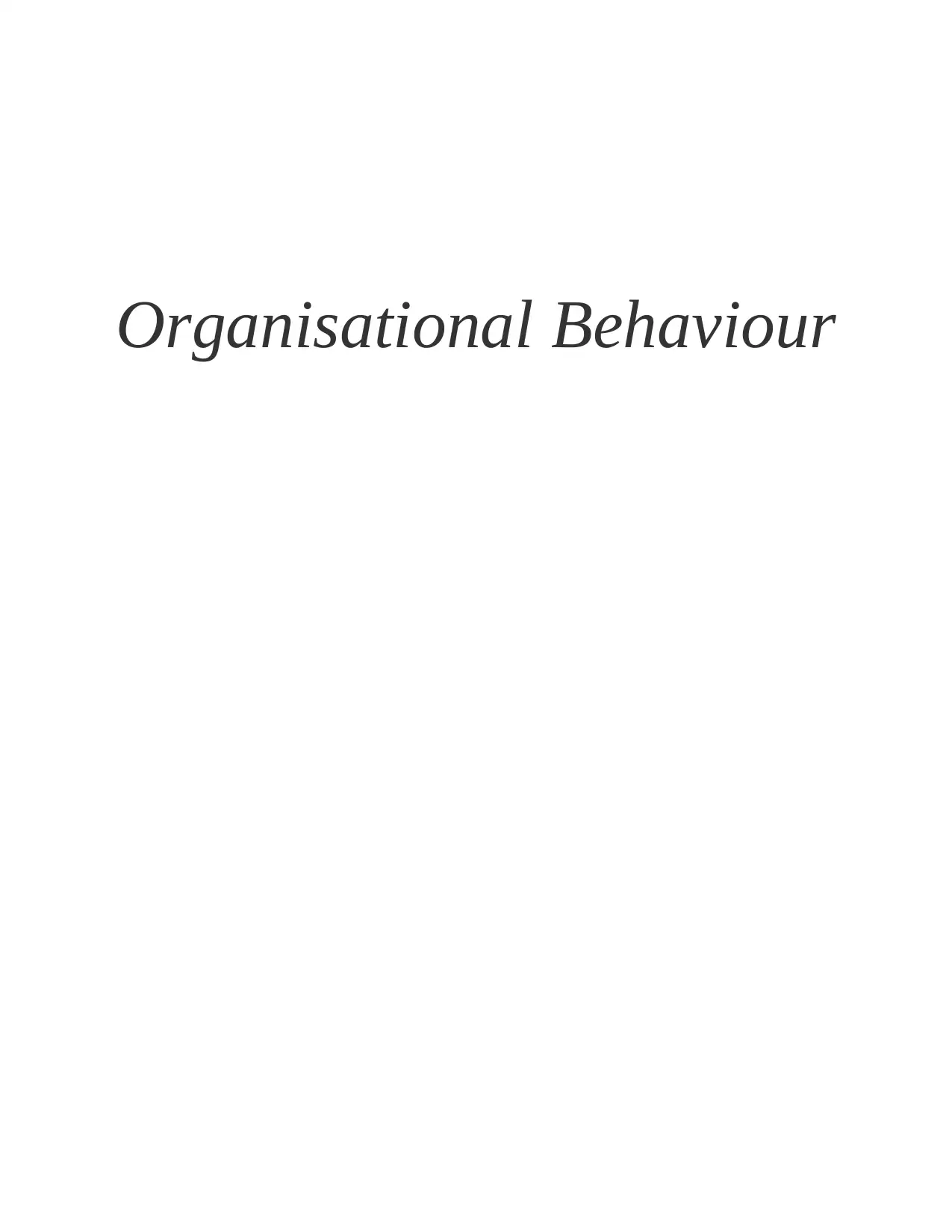
Organisational Behaviour
Secure Best Marks with AI Grader
Need help grading? Try our AI Grader for instant feedback on your assignments.
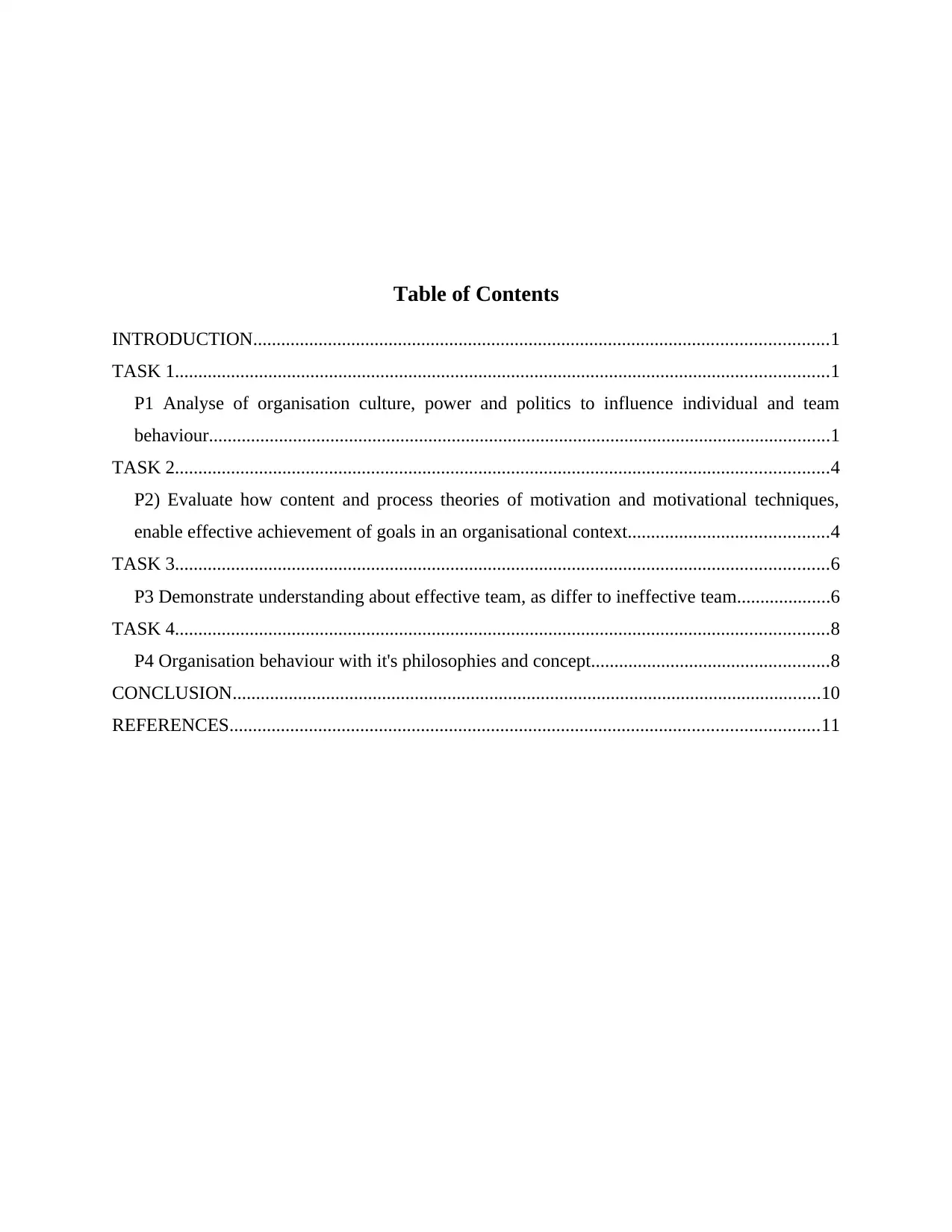
Table of Contents
INTRODUCTION...........................................................................................................................1
TASK 1............................................................................................................................................1
P1 Analyse of organisation culture, power and politics to influence individual and team
behaviour.....................................................................................................................................1
TASK 2............................................................................................................................................4
P2) Evaluate how content and process theories of motivation and motivational techniques,
enable effective achievement of goals in an organisational context...........................................4
TASK 3............................................................................................................................................6
P3 Demonstrate understanding about effective team, as differ to ineffective team....................6
TASK 4............................................................................................................................................8
P4 Organisation behaviour with it's philosophies and concept...................................................8
CONCLUSION..............................................................................................................................10
REFERENCES..............................................................................................................................11
INTRODUCTION...........................................................................................................................1
TASK 1............................................................................................................................................1
P1 Analyse of organisation culture, power and politics to influence individual and team
behaviour.....................................................................................................................................1
TASK 2............................................................................................................................................4
P2) Evaluate how content and process theories of motivation and motivational techniques,
enable effective achievement of goals in an organisational context...........................................4
TASK 3............................................................................................................................................6
P3 Demonstrate understanding about effective team, as differ to ineffective team....................6
TASK 4............................................................................................................................................8
P4 Organisation behaviour with it's philosophies and concept...................................................8
CONCLUSION..............................................................................................................................10
REFERENCES..............................................................................................................................11
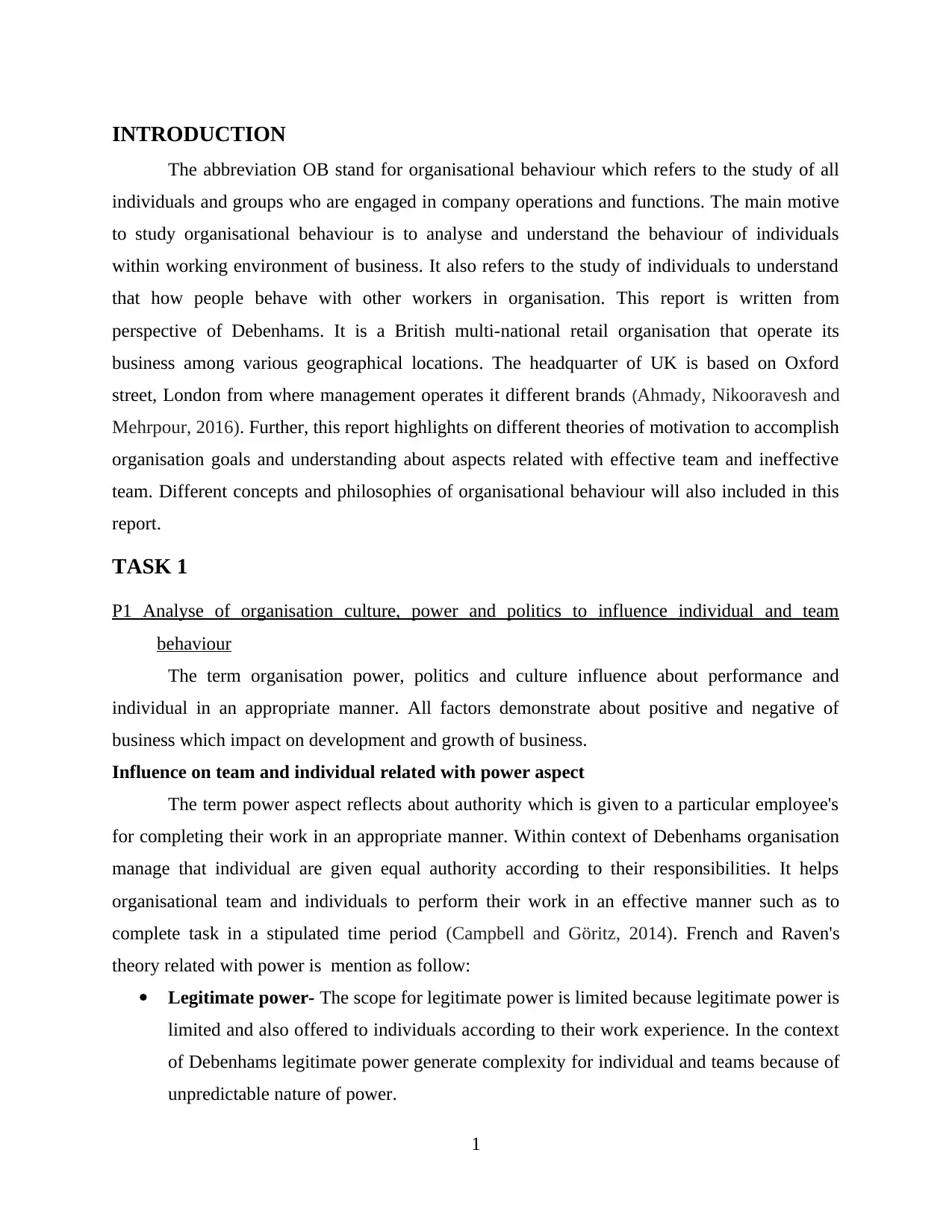
INTRODUCTION
The abbreviation OB stand for organisational behaviour which refers to the study of all
individuals and groups who are engaged in company operations and functions. The main motive
to study organisational behaviour is to analyse and understand the behaviour of individuals
within working environment of business. It also refers to the study of individuals to understand
that how people behave with other workers in organisation. This report is written from
perspective of Debenhams. It is a British multi-national retail organisation that operate its
business among various geographical locations. The headquarter of UK is based on Oxford
street, London from where management operates it different brands (Ahmady, Nikooravesh and
Mehrpour, 2016). Further, this report highlights on different theories of motivation to accomplish
organisation goals and understanding about aspects related with effective team and ineffective
team. Different concepts and philosophies of organisational behaviour will also included in this
report.
TASK 1
P1 Analyse of organisation culture, power and politics to influence individual and team
behaviour
The term organisation power, politics and culture influence about performance and
individual in an appropriate manner. All factors demonstrate about positive and negative of
business which impact on development and growth of business.
Influence on team and individual related with power aspect
The term power aspect reflects about authority which is given to a particular employee's
for completing their work in an appropriate manner. Within context of Debenhams organisation
manage that individual are given equal authority according to their responsibilities. It helps
organisational team and individuals to perform their work in an effective manner such as to
complete task in a stipulated time period (Campbell and Göritz, 2014). French and Raven's
theory related with power is mention as follow:
Legitimate power- The scope for legitimate power is limited because legitimate power is
limited and also offered to individuals according to their work experience. In the context
of Debenhams legitimate power generate complexity for individual and teams because of
unpredictable nature of power.
1
The abbreviation OB stand for organisational behaviour which refers to the study of all
individuals and groups who are engaged in company operations and functions. The main motive
to study organisational behaviour is to analyse and understand the behaviour of individuals
within working environment of business. It also refers to the study of individuals to understand
that how people behave with other workers in organisation. This report is written from
perspective of Debenhams. It is a British multi-national retail organisation that operate its
business among various geographical locations. The headquarter of UK is based on Oxford
street, London from where management operates it different brands (Ahmady, Nikooravesh and
Mehrpour, 2016). Further, this report highlights on different theories of motivation to accomplish
organisation goals and understanding about aspects related with effective team and ineffective
team. Different concepts and philosophies of organisational behaviour will also included in this
report.
TASK 1
P1 Analyse of organisation culture, power and politics to influence individual and team
behaviour
The term organisation power, politics and culture influence about performance and
individual in an appropriate manner. All factors demonstrate about positive and negative of
business which impact on development and growth of business.
Influence on team and individual related with power aspect
The term power aspect reflects about authority which is given to a particular employee's
for completing their work in an appropriate manner. Within context of Debenhams organisation
manage that individual are given equal authority according to their responsibilities. It helps
organisational team and individuals to perform their work in an effective manner such as to
complete task in a stipulated time period (Campbell and Göritz, 2014). French and Raven's
theory related with power is mention as follow:
Legitimate power- The scope for legitimate power is limited because legitimate power is
limited and also offered to individuals according to their work experience. In the context
of Debenhams legitimate power generate complexity for individual and teams because of
unpredictable nature of power.
1
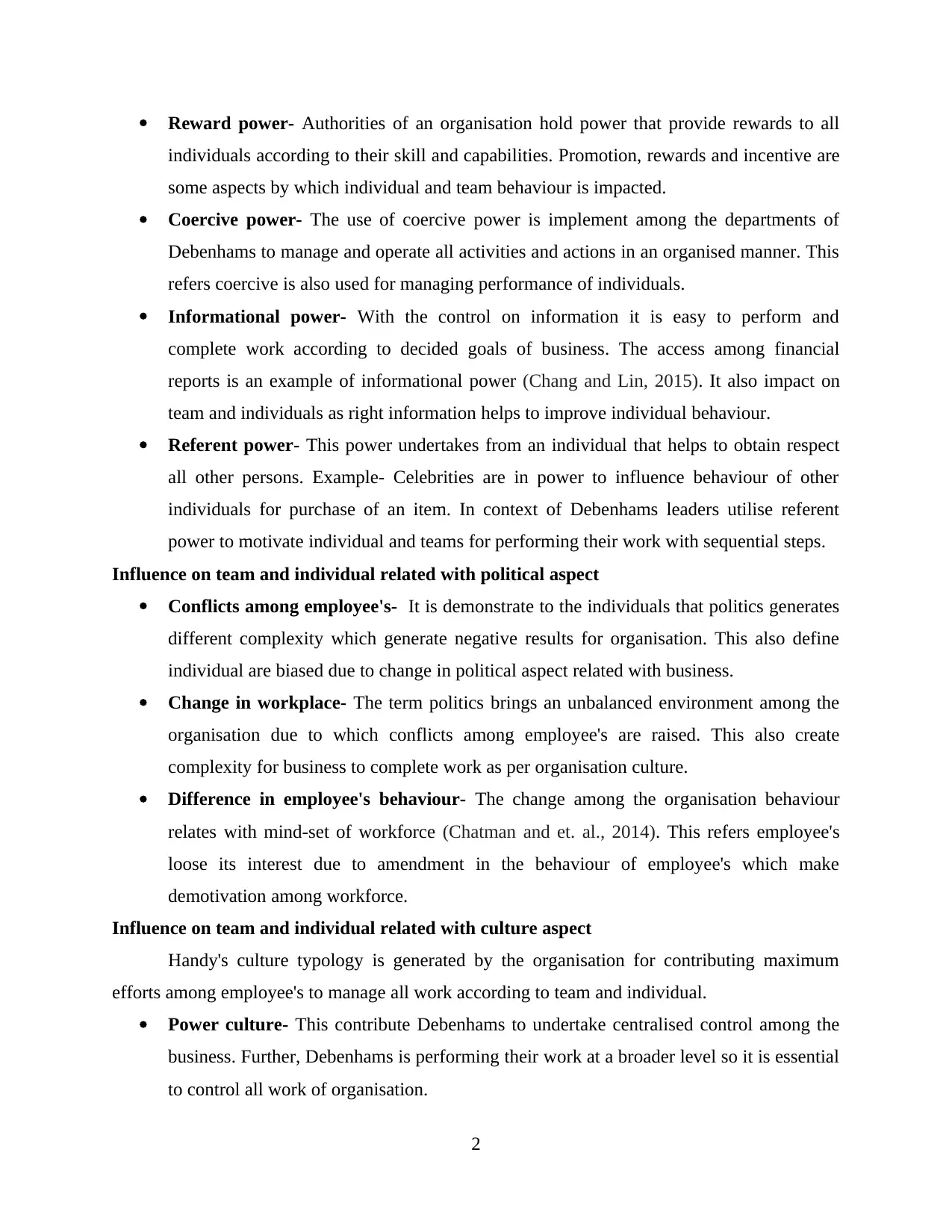
Reward power- Authorities of an organisation hold power that provide rewards to all
individuals according to their skill and capabilities. Promotion, rewards and incentive are
some aspects by which individual and team behaviour is impacted.
Coercive power- The use of coercive power is implement among the departments of
Debenhams to manage and operate all activities and actions in an organised manner. This
refers coercive is also used for managing performance of individuals.
Informational power- With the control on information it is easy to perform and
complete work according to decided goals of business. The access among financial
reports is an example of informational power (Chang and Lin, 2015). It also impact on
team and individuals as right information helps to improve individual behaviour.
Referent power- This power undertakes from an individual that helps to obtain respect
all other persons. Example- Celebrities are in power to influence behaviour of other
individuals for purchase of an item. In context of Debenhams leaders utilise referent
power to motivate individual and teams for performing their work with sequential steps.
Influence on team and individual related with political aspect
Conflicts among employee's- It is demonstrate to the individuals that politics generates
different complexity which generate negative results for organisation. This also define
individual are biased due to change in political aspect related with business.
Change in workplace- The term politics brings an unbalanced environment among the
organisation due to which conflicts among employee's are raised. This also create
complexity for business to complete work as per organisation culture.
Difference in employee's behaviour- The change among the organisation behaviour
relates with mind-set of workforce (Chatman and et. al., 2014). This refers employee's
loose its interest due to amendment in the behaviour of employee's which make
demotivation among workforce.
Influence on team and individual related with culture aspect
Handy's culture typology is generated by the organisation for contributing maximum
efforts among employee's to manage all work according to team and individual.
Power culture- This contribute Debenhams to undertake centralised control among the
business. Further, Debenhams is performing their work at a broader level so it is essential
to control all work of organisation.
2
individuals according to their skill and capabilities. Promotion, rewards and incentive are
some aspects by which individual and team behaviour is impacted.
Coercive power- The use of coercive power is implement among the departments of
Debenhams to manage and operate all activities and actions in an organised manner. This
refers coercive is also used for managing performance of individuals.
Informational power- With the control on information it is easy to perform and
complete work according to decided goals of business. The access among financial
reports is an example of informational power (Chang and Lin, 2015). It also impact on
team and individuals as right information helps to improve individual behaviour.
Referent power- This power undertakes from an individual that helps to obtain respect
all other persons. Example- Celebrities are in power to influence behaviour of other
individuals for purchase of an item. In context of Debenhams leaders utilise referent
power to motivate individual and teams for performing their work with sequential steps.
Influence on team and individual related with political aspect
Conflicts among employee's- It is demonstrate to the individuals that politics generates
different complexity which generate negative results for organisation. This also define
individual are biased due to change in political aspect related with business.
Change in workplace- The term politics brings an unbalanced environment among the
organisation due to which conflicts among employee's are raised. This also create
complexity for business to complete work as per organisation culture.
Difference in employee's behaviour- The change among the organisation behaviour
relates with mind-set of workforce (Chatman and et. al., 2014). This refers employee's
loose its interest due to amendment in the behaviour of employee's which make
demotivation among workforce.
Influence on team and individual related with culture aspect
Handy's culture typology is generated by the organisation for contributing maximum
efforts among employee's to manage all work according to team and individual.
Power culture- This contribute Debenhams to undertake centralised control among the
business. Further, Debenhams is performing their work at a broader level so it is essential
to control all work of organisation.
2
Secure Best Marks with AI Grader
Need help grading? Try our AI Grader for instant feedback on your assignments.
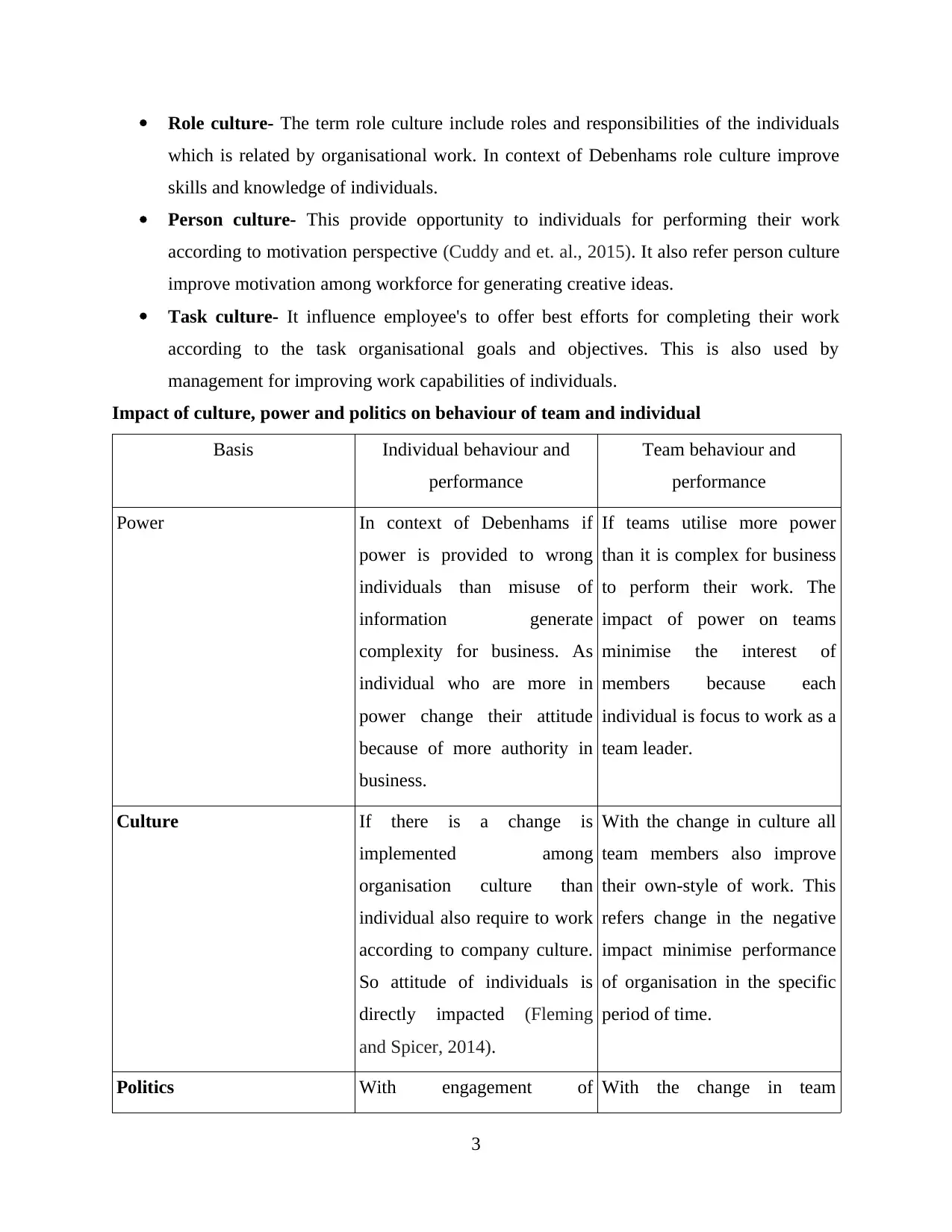
Role culture- The term role culture include roles and responsibilities of the individuals
which is related by organisational work. In context of Debenhams role culture improve
skills and knowledge of individuals.
Person culture- This provide opportunity to individuals for performing their work
according to motivation perspective (Cuddy and et. al., 2015). It also refer person culture
improve motivation among workforce for generating creative ideas.
Task culture- It influence employee's to offer best efforts for completing their work
according to the task organisational goals and objectives. This is also used by
management for improving work capabilities of individuals.
Impact of culture, power and politics on behaviour of team and individual
Basis Individual behaviour and
performance
Team behaviour and
performance
Power In context of Debenhams if
power is provided to wrong
individuals than misuse of
information generate
complexity for business. As
individual who are more in
power change their attitude
because of more authority in
business.
If teams utilise more power
than it is complex for business
to perform their work. The
impact of power on teams
minimise the interest of
members because each
individual is focus to work as a
team leader.
Culture If there is a change is
implemented among
organisation culture than
individual also require to work
according to company culture.
So attitude of individuals is
directly impacted (Fleming
and Spicer, 2014).
With the change in culture all
team members also improve
their own-style of work. This
refers change in the negative
impact minimise performance
of organisation in the specific
period of time.
Politics With engagement of With the change in team
3
which is related by organisational work. In context of Debenhams role culture improve
skills and knowledge of individuals.
Person culture- This provide opportunity to individuals for performing their work
according to motivation perspective (Cuddy and et. al., 2015). It also refer person culture
improve motivation among workforce for generating creative ideas.
Task culture- It influence employee's to offer best efforts for completing their work
according to the task organisational goals and objectives. This is also used by
management for improving work capabilities of individuals.
Impact of culture, power and politics on behaviour of team and individual
Basis Individual behaviour and
performance
Team behaviour and
performance
Power In context of Debenhams if
power is provided to wrong
individuals than misuse of
information generate
complexity for business. As
individual who are more in
power change their attitude
because of more authority in
business.
If teams utilise more power
than it is complex for business
to perform their work. The
impact of power on teams
minimise the interest of
members because each
individual is focus to work as a
team leader.
Culture If there is a change is
implemented among
organisation culture than
individual also require to work
according to company culture.
So attitude of individuals is
directly impacted (Fleming
and Spicer, 2014).
With the change in culture all
team members also improve
their own-style of work. This
refers change in the negative
impact minimise performance
of organisation in the specific
period of time.
Politics With engagement of With the change in team
3
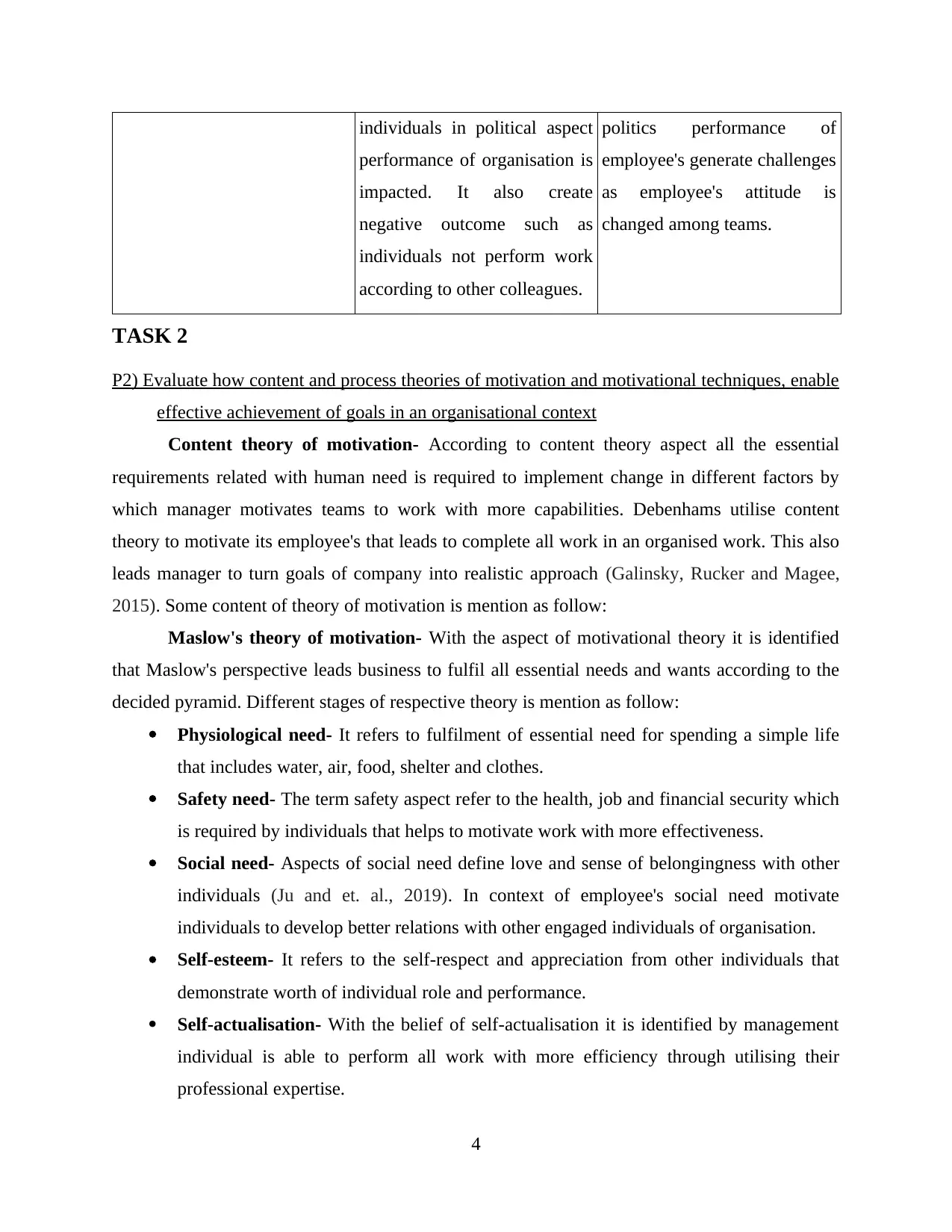
individuals in political aspect
performance of organisation is
impacted. It also create
negative outcome such as
individuals not perform work
according to other colleagues.
politics performance of
employee's generate challenges
as employee's attitude is
changed among teams.
TASK 2
P2) Evaluate how content and process theories of motivation and motivational techniques, enable
effective achievement of goals in an organisational context
Content theory of motivation- According to content theory aspect all the essential
requirements related with human need is required to implement change in different factors by
which manager motivates teams to work with more capabilities. Debenhams utilise content
theory to motivate its employee's that leads to complete all work in an organised work. This also
leads manager to turn goals of company into realistic approach (Galinsky, Rucker and Magee,
2015). Some content of theory of motivation is mention as follow:
Maslow's theory of motivation- With the aspect of motivational theory it is identified
that Maslow's perspective leads business to fulfil all essential needs and wants according to the
decided pyramid. Different stages of respective theory is mention as follow:
Physiological need- It refers to fulfilment of essential need for spending a simple life
that includes water, air, food, shelter and clothes.
Safety need- The term safety aspect refer to the health, job and financial security which
is required by individuals that helps to motivate work with more effectiveness.
Social need- Aspects of social need define love and sense of belongingness with other
individuals (Ju and et. al., 2019). In context of employee's social need motivate
individuals to develop better relations with other engaged individuals of organisation.
Self-esteem- It refers to the self-respect and appreciation from other individuals that
demonstrate worth of individual role and performance.
Self-actualisation- With the belief of self-actualisation it is identified by management
individual is able to perform all work with more efficiency through utilising their
professional expertise.
4
performance of organisation is
impacted. It also create
negative outcome such as
individuals not perform work
according to other colleagues.
politics performance of
employee's generate challenges
as employee's attitude is
changed among teams.
TASK 2
P2) Evaluate how content and process theories of motivation and motivational techniques, enable
effective achievement of goals in an organisational context
Content theory of motivation- According to content theory aspect all the essential
requirements related with human need is required to implement change in different factors by
which manager motivates teams to work with more capabilities. Debenhams utilise content
theory to motivate its employee's that leads to complete all work in an organised work. This also
leads manager to turn goals of company into realistic approach (Galinsky, Rucker and Magee,
2015). Some content of theory of motivation is mention as follow:
Maslow's theory of motivation- With the aspect of motivational theory it is identified
that Maslow's perspective leads business to fulfil all essential needs and wants according to the
decided pyramid. Different stages of respective theory is mention as follow:
Physiological need- It refers to fulfilment of essential need for spending a simple life
that includes water, air, food, shelter and clothes.
Safety need- The term safety aspect refer to the health, job and financial security which
is required by individuals that helps to motivate work with more effectiveness.
Social need- Aspects of social need define love and sense of belongingness with other
individuals (Ju and et. al., 2019). In context of employee's social need motivate
individuals to develop better relations with other engaged individuals of organisation.
Self-esteem- It refers to the self-respect and appreciation from other individuals that
demonstrate worth of individual role and performance.
Self-actualisation- With the belief of self-actualisation it is identified by management
individual is able to perform all work with more efficiency through utilising their
professional expertise.
4
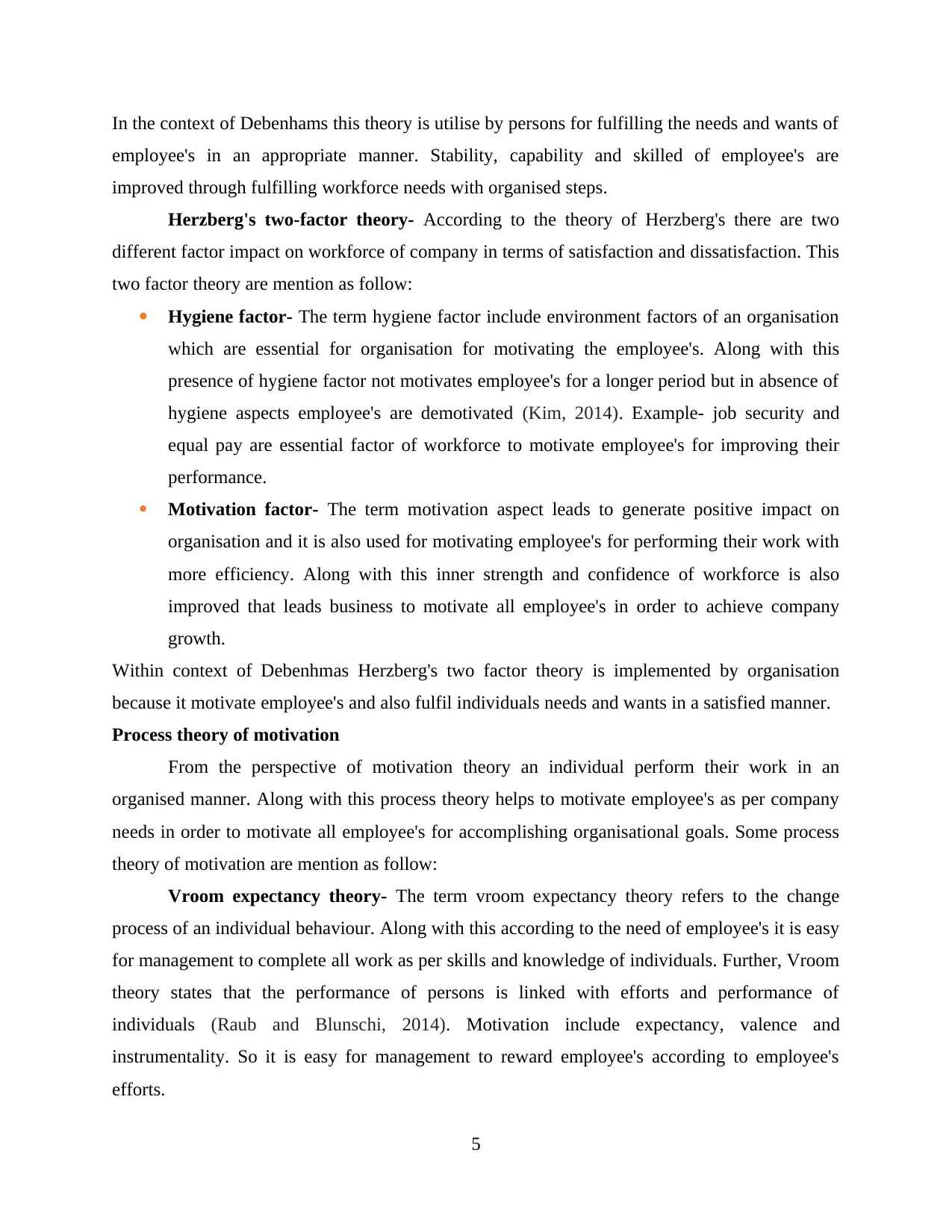
In the context of Debenhams this theory is utilise by persons for fulfilling the needs and wants of
employee's in an appropriate manner. Stability, capability and skilled of employee's are
improved through fulfilling workforce needs with organised steps.
Herzberg's two-factor theory- According to the theory of Herzberg's there are two
different factor impact on workforce of company in terms of satisfaction and dissatisfaction. This
two factor theory are mention as follow:
Hygiene factor- The term hygiene factor include environment factors of an organisation
which are essential for organisation for motivating the employee's. Along with this
presence of hygiene factor not motivates employee's for a longer period but in absence of
hygiene aspects employee's are demotivated (Kim, 2014). Example- job security and
equal pay are essential factor of workforce to motivate employee's for improving their
performance.
Motivation factor- The term motivation aspect leads to generate positive impact on
organisation and it is also used for motivating employee's for performing their work with
more efficiency. Along with this inner strength and confidence of workforce is also
improved that leads business to motivate all employee's in order to achieve company
growth.
Within context of Debenhmas Herzberg's two factor theory is implemented by organisation
because it motivate employee's and also fulfil individuals needs and wants in a satisfied manner.
Process theory of motivation
From the perspective of motivation theory an individual perform their work in an
organised manner. Along with this process theory helps to motivate employee's as per company
needs in order to motivate all employee's for accomplishing organisational goals. Some process
theory of motivation are mention as follow:
Vroom expectancy theory- The term vroom expectancy theory refers to the change
process of an individual behaviour. Along with this according to the need of employee's it is easy
for management to complete all work as per skills and knowledge of individuals. Further, Vroom
theory states that the performance of persons is linked with efforts and performance of
individuals (Raub and Blunschi, 2014). Motivation include expectancy, valence and
instrumentality. So it is easy for management to reward employee's according to employee's
efforts.
5
employee's in an appropriate manner. Stability, capability and skilled of employee's are
improved through fulfilling workforce needs with organised steps.
Herzberg's two-factor theory- According to the theory of Herzberg's there are two
different factor impact on workforce of company in terms of satisfaction and dissatisfaction. This
two factor theory are mention as follow:
Hygiene factor- The term hygiene factor include environment factors of an organisation
which are essential for organisation for motivating the employee's. Along with this
presence of hygiene factor not motivates employee's for a longer period but in absence of
hygiene aspects employee's are demotivated (Kim, 2014). Example- job security and
equal pay are essential factor of workforce to motivate employee's for improving their
performance.
Motivation factor- The term motivation aspect leads to generate positive impact on
organisation and it is also used for motivating employee's for performing their work with
more efficiency. Along with this inner strength and confidence of workforce is also
improved that leads business to motivate all employee's in order to achieve company
growth.
Within context of Debenhmas Herzberg's two factor theory is implemented by organisation
because it motivate employee's and also fulfil individuals needs and wants in a satisfied manner.
Process theory of motivation
From the perspective of motivation theory an individual perform their work in an
organised manner. Along with this process theory helps to motivate employee's as per company
needs in order to motivate all employee's for accomplishing organisational goals. Some process
theory of motivation are mention as follow:
Vroom expectancy theory- The term vroom expectancy theory refers to the change
process of an individual behaviour. Along with this according to the need of employee's it is easy
for management to complete all work as per skills and knowledge of individuals. Further, Vroom
theory states that the performance of persons is linked with efforts and performance of
individuals (Raub and Blunschi, 2014). Motivation include expectancy, valence and
instrumentality. So it is easy for management to reward employee's according to employee's
efforts.
5
Paraphrase This Document
Need a fresh take? Get an instant paraphrase of this document with our AI Paraphraser
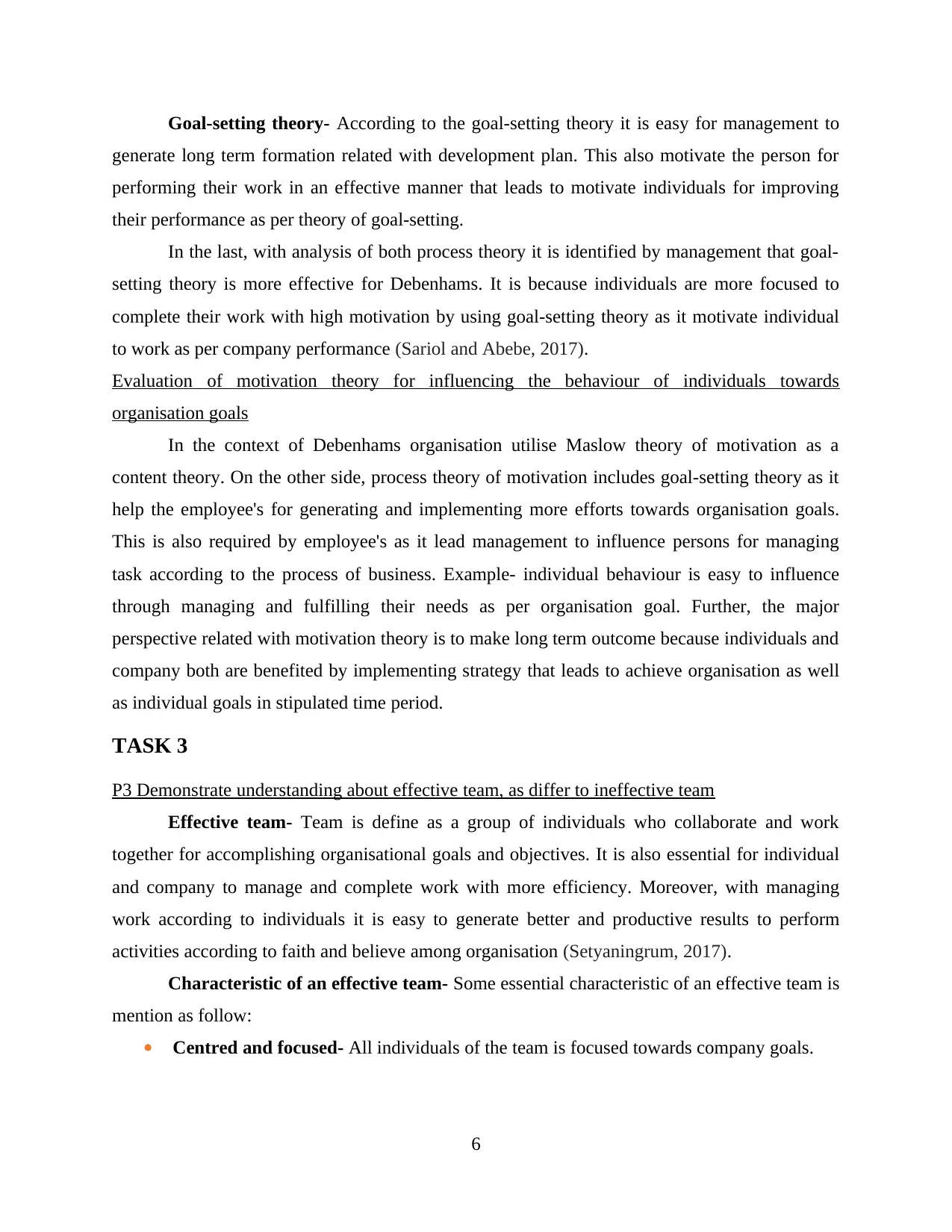
Goal-setting theory- According to the goal-setting theory it is easy for management to
generate long term formation related with development plan. This also motivate the person for
performing their work in an effective manner that leads to motivate individuals for improving
their performance as per theory of goal-setting.
In the last, with analysis of both process theory it is identified by management that goal-
setting theory is more effective for Debenhams. It is because individuals are more focused to
complete their work with high motivation by using goal-setting theory as it motivate individual
to work as per company performance (Sariol and Abebe, 2017).
Evaluation of motivation theory for influencing the behaviour of individuals towards
organisation goals
In the context of Debenhams organisation utilise Maslow theory of motivation as a
content theory. On the other side, process theory of motivation includes goal-setting theory as it
help the employee's for generating and implementing more efforts towards organisation goals.
This is also required by employee's as it lead management to influence persons for managing
task according to the process of business. Example- individual behaviour is easy to influence
through managing and fulfilling their needs as per organisation goal. Further, the major
perspective related with motivation theory is to make long term outcome because individuals and
company both are benefited by implementing strategy that leads to achieve organisation as well
as individual goals in stipulated time period.
TASK 3
P3 Demonstrate understanding about effective team, as differ to ineffective team
Effective team- Team is define as a group of individuals who collaborate and work
together for accomplishing organisational goals and objectives. It is also essential for individual
and company to manage and complete work with more efficiency. Moreover, with managing
work according to individuals it is easy to generate better and productive results to perform
activities according to faith and believe among organisation (Setyaningrum, 2017).
Characteristic of an effective team- Some essential characteristic of an effective team is
mention as follow:
Centred and focused- All individuals of the team is focused towards company goals.
6
generate long term formation related with development plan. This also motivate the person for
performing their work in an effective manner that leads to motivate individuals for improving
their performance as per theory of goal-setting.
In the last, with analysis of both process theory it is identified by management that goal-
setting theory is more effective for Debenhams. It is because individuals are more focused to
complete their work with high motivation by using goal-setting theory as it motivate individual
to work as per company performance (Sariol and Abebe, 2017).
Evaluation of motivation theory for influencing the behaviour of individuals towards
organisation goals
In the context of Debenhams organisation utilise Maslow theory of motivation as a
content theory. On the other side, process theory of motivation includes goal-setting theory as it
help the employee's for generating and implementing more efforts towards organisation goals.
This is also required by employee's as it lead management to influence persons for managing
task according to the process of business. Example- individual behaviour is easy to influence
through managing and fulfilling their needs as per organisation goal. Further, the major
perspective related with motivation theory is to make long term outcome because individuals and
company both are benefited by implementing strategy that leads to achieve organisation as well
as individual goals in stipulated time period.
TASK 3
P3 Demonstrate understanding about effective team, as differ to ineffective team
Effective team- Team is define as a group of individuals who collaborate and work
together for accomplishing organisational goals and objectives. It is also essential for individual
and company to manage and complete work with more efficiency. Moreover, with managing
work according to individuals it is easy to generate better and productive results to perform
activities according to faith and believe among organisation (Setyaningrum, 2017).
Characteristic of an effective team- Some essential characteristic of an effective team is
mention as follow:
Centred and focused- All individuals of the team is focused towards company goals.
6
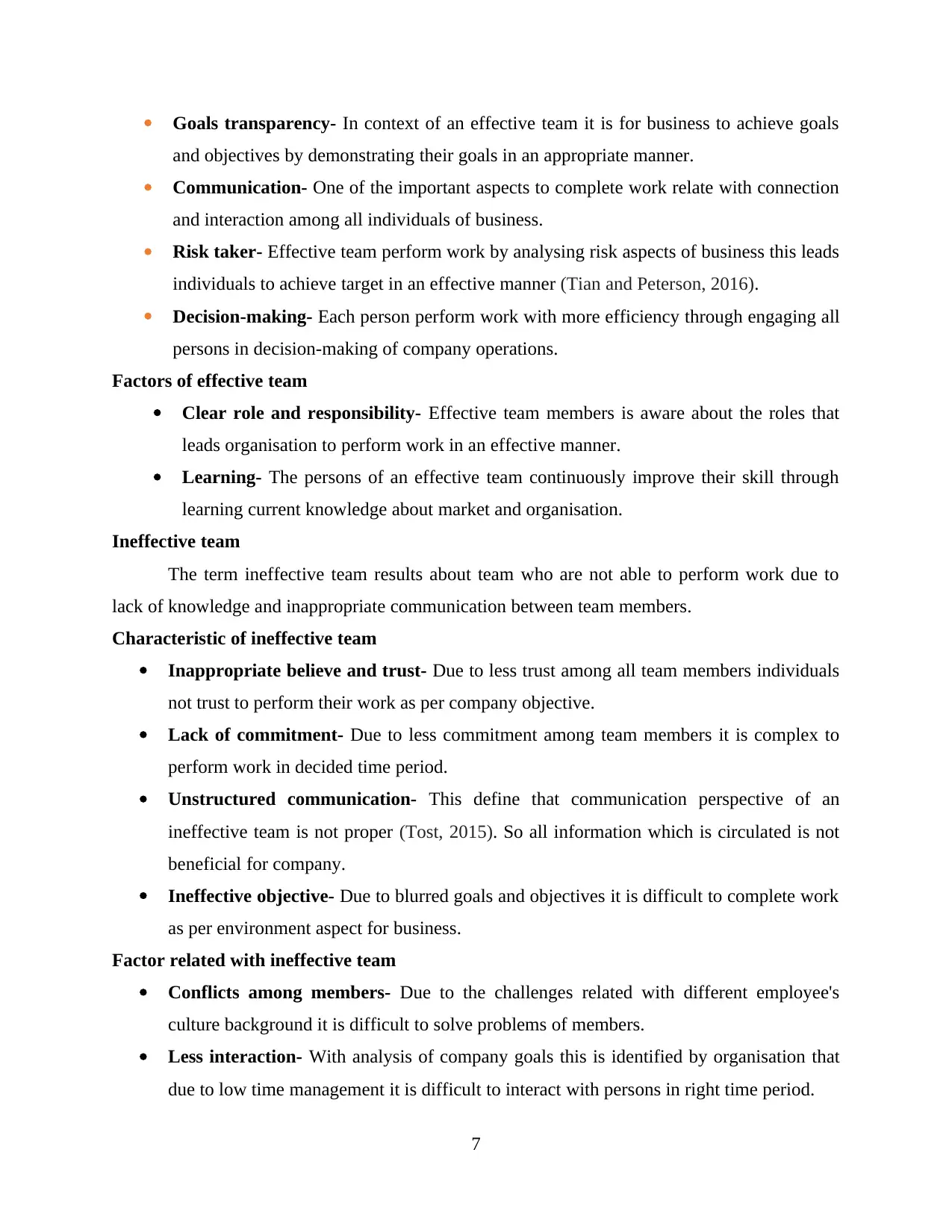
Goals transparency- In context of an effective team it is for business to achieve goals
and objectives by demonstrating their goals in an appropriate manner.
Communication- One of the important aspects to complete work relate with connection
and interaction among all individuals of business.
Risk taker- Effective team perform work by analysing risk aspects of business this leads
individuals to achieve target in an effective manner (Tian and Peterson, 2016).
Decision-making- Each person perform work with more efficiency through engaging all
persons in decision-making of company operations.
Factors of effective team
Clear role and responsibility- Effective team members is aware about the roles that
leads organisation to perform work in an effective manner.
Learning- The persons of an effective team continuously improve their skill through
learning current knowledge about market and organisation.
Ineffective team
The term ineffective team results about team who are not able to perform work due to
lack of knowledge and inappropriate communication between team members.
Characteristic of ineffective team
Inappropriate believe and trust- Due to less trust among all team members individuals
not trust to perform their work as per company objective.
Lack of commitment- Due to less commitment among team members it is complex to
perform work in decided time period.
Unstructured communication- This define that communication perspective of an
ineffective team is not proper (Tost, 2015). So all information which is circulated is not
beneficial for company.
Ineffective objective- Due to blurred goals and objectives it is difficult to complete work
as per environment aspect for business.
Factor related with ineffective team
Conflicts among members- Due to the challenges related with different employee's
culture background it is difficult to solve problems of members.
Less interaction- With analysis of company goals this is identified by organisation that
due to low time management it is difficult to interact with persons in right time period.
7
and objectives by demonstrating their goals in an appropriate manner.
Communication- One of the important aspects to complete work relate with connection
and interaction among all individuals of business.
Risk taker- Effective team perform work by analysing risk aspects of business this leads
individuals to achieve target in an effective manner (Tian and Peterson, 2016).
Decision-making- Each person perform work with more efficiency through engaging all
persons in decision-making of company operations.
Factors of effective team
Clear role and responsibility- Effective team members is aware about the roles that
leads organisation to perform work in an effective manner.
Learning- The persons of an effective team continuously improve their skill through
learning current knowledge about market and organisation.
Ineffective team
The term ineffective team results about team who are not able to perform work due to
lack of knowledge and inappropriate communication between team members.
Characteristic of ineffective team
Inappropriate believe and trust- Due to less trust among all team members individuals
not trust to perform their work as per company objective.
Lack of commitment- Due to less commitment among team members it is complex to
perform work in decided time period.
Unstructured communication- This define that communication perspective of an
ineffective team is not proper (Tost, 2015). So all information which is circulated is not
beneficial for company.
Ineffective objective- Due to blurred goals and objectives it is difficult to complete work
as per environment aspect for business.
Factor related with ineffective team
Conflicts among members- Due to the challenges related with different employee's
culture background it is difficult to solve problems of members.
Less interaction- With analysis of company goals this is identified by organisation that
due to low time management it is difficult to interact with persons in right time period.
7
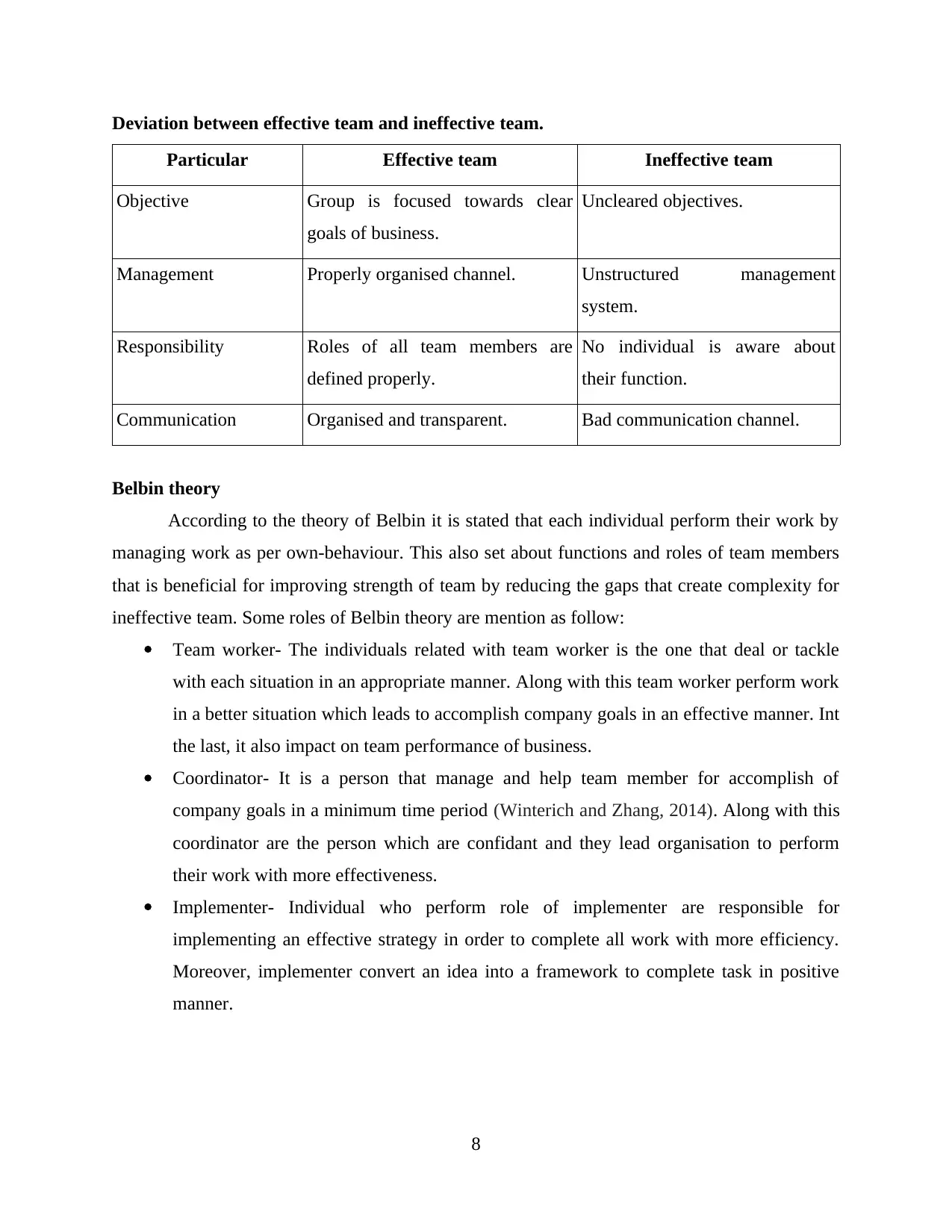
Deviation between effective team and ineffective team.
Particular Effective team Ineffective team
Objective Group is focused towards clear
goals of business.
Uncleared objectives.
Management Properly organised channel. Unstructured management
system.
Responsibility Roles of all team members are
defined properly.
No individual is aware about
their function.
Communication Organised and transparent. Bad communication channel.
Belbin theory
According to the theory of Belbin it is stated that each individual perform their work by
managing work as per own-behaviour. This also set about functions and roles of team members
that is beneficial for improving strength of team by reducing the gaps that create complexity for
ineffective team. Some roles of Belbin theory are mention as follow:
Team worker- The individuals related with team worker is the one that deal or tackle
with each situation in an appropriate manner. Along with this team worker perform work
in a better situation which leads to accomplish company goals in an effective manner. Int
the last, it also impact on team performance of business.
Coordinator- It is a person that manage and help team member for accomplish of
company goals in a minimum time period (Winterich and Zhang, 2014). Along with this
coordinator are the person which are confidant and they lead organisation to perform
their work with more effectiveness.
Implementer- Individual who perform role of implementer are responsible for
implementing an effective strategy in order to complete all work with more efficiency.
Moreover, implementer convert an idea into a framework to complete task in positive
manner.
8
Particular Effective team Ineffective team
Objective Group is focused towards clear
goals of business.
Uncleared objectives.
Management Properly organised channel. Unstructured management
system.
Responsibility Roles of all team members are
defined properly.
No individual is aware about
their function.
Communication Organised and transparent. Bad communication channel.
Belbin theory
According to the theory of Belbin it is stated that each individual perform their work by
managing work as per own-behaviour. This also set about functions and roles of team members
that is beneficial for improving strength of team by reducing the gaps that create complexity for
ineffective team. Some roles of Belbin theory are mention as follow:
Team worker- The individuals related with team worker is the one that deal or tackle
with each situation in an appropriate manner. Along with this team worker perform work
in a better situation which leads to accomplish company goals in an effective manner. Int
the last, it also impact on team performance of business.
Coordinator- It is a person that manage and help team member for accomplish of
company goals in a minimum time period (Winterich and Zhang, 2014). Along with this
coordinator are the person which are confidant and they lead organisation to perform
their work with more effectiveness.
Implementer- Individual who perform role of implementer are responsible for
implementing an effective strategy in order to complete all work with more efficiency.
Moreover, implementer convert an idea into a framework to complete task in positive
manner.
8
Secure Best Marks with AI Grader
Need help grading? Try our AI Grader for instant feedback on your assignments.
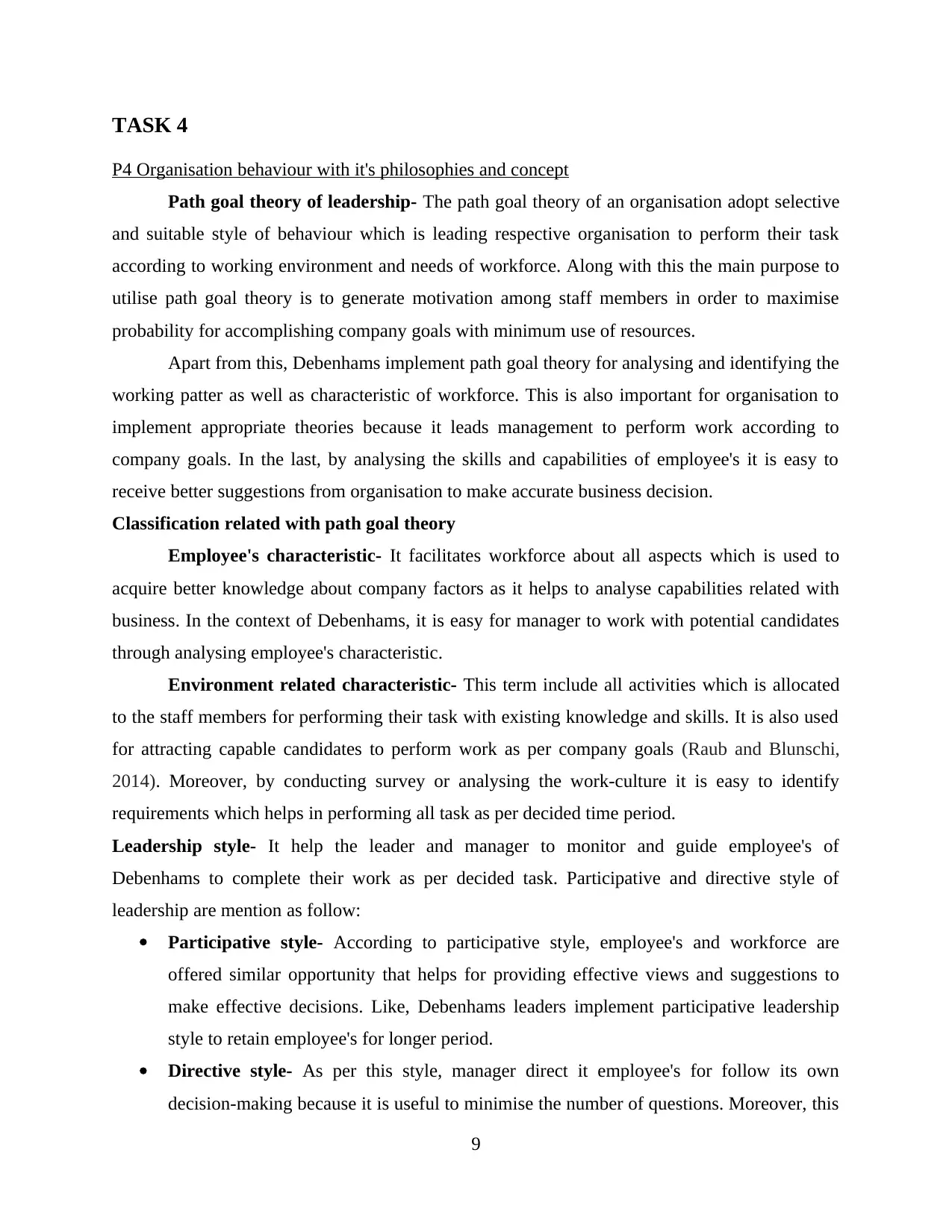
TASK 4
P4 Organisation behaviour with it's philosophies and concept
Path goal theory of leadership- The path goal theory of an organisation adopt selective
and suitable style of behaviour which is leading respective organisation to perform their task
according to working environment and needs of workforce. Along with this the main purpose to
utilise path goal theory is to generate motivation among staff members in order to maximise
probability for accomplishing company goals with minimum use of resources.
Apart from this, Debenhams implement path goal theory for analysing and identifying the
working patter as well as characteristic of workforce. This is also important for organisation to
implement appropriate theories because it leads management to perform work according to
company goals. In the last, by analysing the skills and capabilities of employee's it is easy to
receive better suggestions from organisation to make accurate business decision.
Classification related with path goal theory
Employee's characteristic- It facilitates workforce about all aspects which is used to
acquire better knowledge about company factors as it helps to analyse capabilities related with
business. In the context of Debenhams, it is easy for manager to work with potential candidates
through analysing employee's characteristic.
Environment related characteristic- This term include all activities which is allocated
to the staff members for performing their task with existing knowledge and skills. It is also used
for attracting capable candidates to perform work as per company goals (Raub and Blunschi,
2014). Moreover, by conducting survey or analysing the work-culture it is easy to identify
requirements which helps in performing all task as per decided time period.
Leadership style- It help the leader and manager to monitor and guide employee's of
Debenhams to complete their work as per decided task. Participative and directive style of
leadership are mention as follow:
Participative style- According to participative style, employee's and workforce are
offered similar opportunity that helps for providing effective views and suggestions to
make effective decisions. Like, Debenhams leaders implement participative leadership
style to retain employee's for longer period.
Directive style- As per this style, manager direct it employee's for follow its own
decision-making because it is useful to minimise the number of questions. Moreover, this
9
P4 Organisation behaviour with it's philosophies and concept
Path goal theory of leadership- The path goal theory of an organisation adopt selective
and suitable style of behaviour which is leading respective organisation to perform their task
according to working environment and needs of workforce. Along with this the main purpose to
utilise path goal theory is to generate motivation among staff members in order to maximise
probability for accomplishing company goals with minimum use of resources.
Apart from this, Debenhams implement path goal theory for analysing and identifying the
working patter as well as characteristic of workforce. This is also important for organisation to
implement appropriate theories because it leads management to perform work according to
company goals. In the last, by analysing the skills and capabilities of employee's it is easy to
receive better suggestions from organisation to make accurate business decision.
Classification related with path goal theory
Employee's characteristic- It facilitates workforce about all aspects which is used to
acquire better knowledge about company factors as it helps to analyse capabilities related with
business. In the context of Debenhams, it is easy for manager to work with potential candidates
through analysing employee's characteristic.
Environment related characteristic- This term include all activities which is allocated
to the staff members for performing their task with existing knowledge and skills. It is also used
for attracting capable candidates to perform work as per company goals (Raub and Blunschi,
2014). Moreover, by conducting survey or analysing the work-culture it is easy to identify
requirements which helps in performing all task as per decided time period.
Leadership style- It help the leader and manager to monitor and guide employee's of
Debenhams to complete their work as per decided task. Participative and directive style of
leadership are mention as follow:
Participative style- According to participative style, employee's and workforce are
offered similar opportunity that helps for providing effective views and suggestions to
make effective decisions. Like, Debenhams leaders implement participative leadership
style to retain employee's for longer period.
Directive style- As per this style, manager direct it employee's for follow its own
decision-making because it is useful to minimise the number of questions. Moreover, this
9
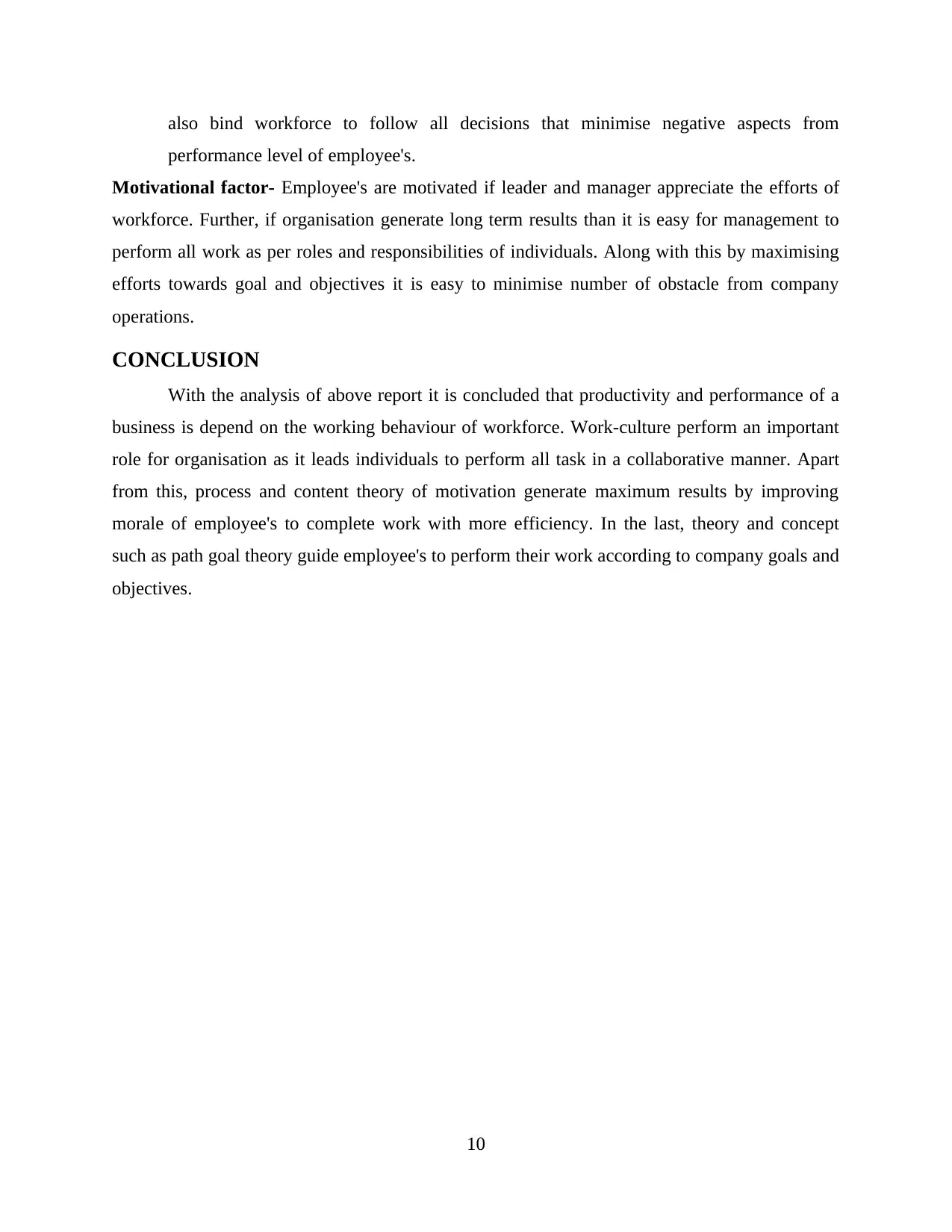
also bind workforce to follow all decisions that minimise negative aspects from
performance level of employee's.
Motivational factor- Employee's are motivated if leader and manager appreciate the efforts of
workforce. Further, if organisation generate long term results than it is easy for management to
perform all work as per roles and responsibilities of individuals. Along with this by maximising
efforts towards goal and objectives it is easy to minimise number of obstacle from company
operations.
CONCLUSION
With the analysis of above report it is concluded that productivity and performance of a
business is depend on the working behaviour of workforce. Work-culture perform an important
role for organisation as it leads individuals to perform all task in a collaborative manner. Apart
from this, process and content theory of motivation generate maximum results by improving
morale of employee's to complete work with more efficiency. In the last, theory and concept
such as path goal theory guide employee's to perform their work according to company goals and
objectives.
10
performance level of employee's.
Motivational factor- Employee's are motivated if leader and manager appreciate the efforts of
workforce. Further, if organisation generate long term results than it is easy for management to
perform all work as per roles and responsibilities of individuals. Along with this by maximising
efforts towards goal and objectives it is easy to minimise number of obstacle from company
operations.
CONCLUSION
With the analysis of above report it is concluded that productivity and performance of a
business is depend on the working behaviour of workforce. Work-culture perform an important
role for organisation as it leads individuals to perform all task in a collaborative manner. Apart
from this, process and content theory of motivation generate maximum results by improving
morale of employee's to complete work with more efficiency. In the last, theory and concept
such as path goal theory guide employee's to perform their work according to company goals and
objectives.
10
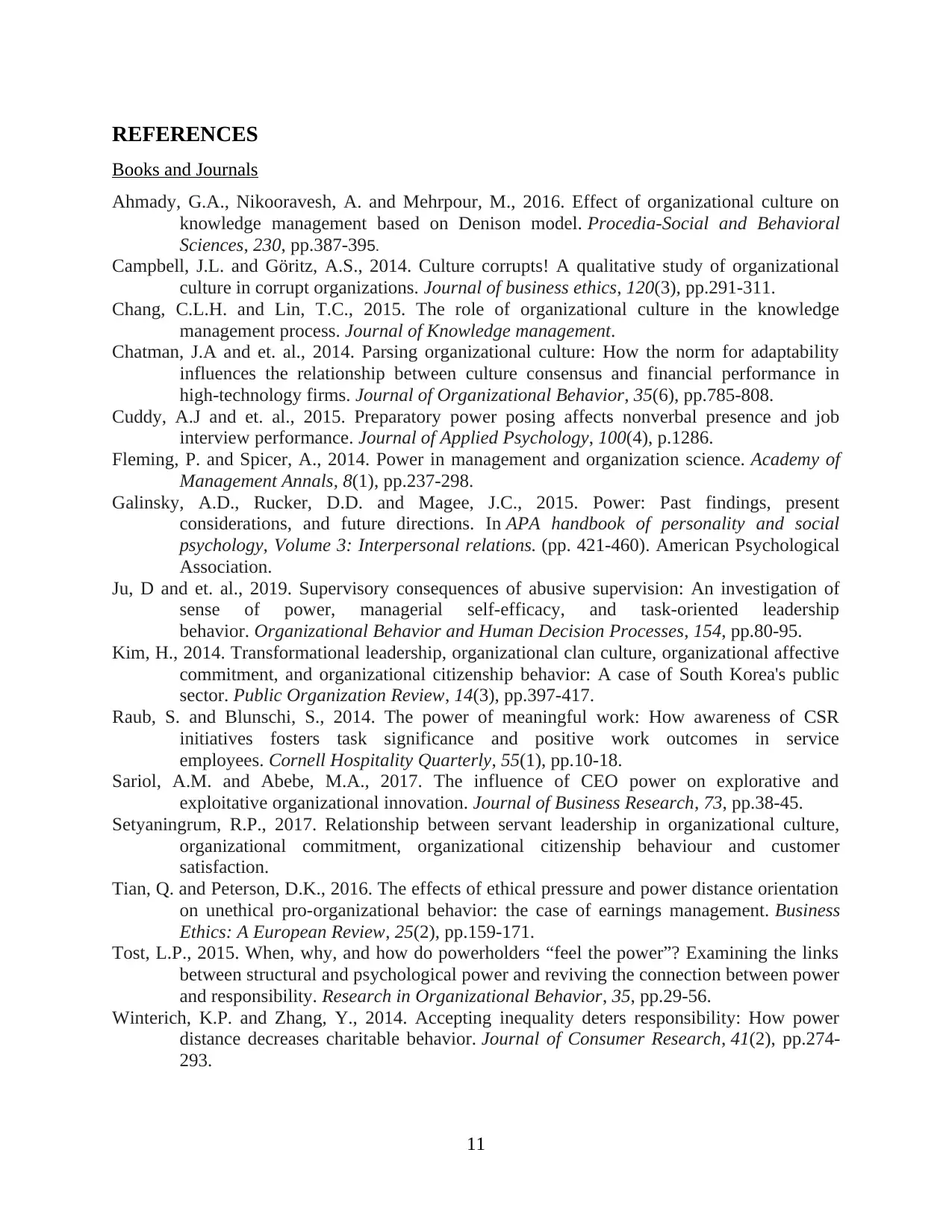
REFERENCES
Books and Journals
Ahmady, G.A., Nikooravesh, A. and Mehrpour, M., 2016. Effect of organizational culture on
knowledge management based on Denison model. Procedia-Social and Behavioral
Sciences, 230, pp.387-395.
Campbell, J.L. and Göritz, A.S., 2014. Culture corrupts! A qualitative study of organizational
culture in corrupt organizations. Journal of business ethics, 120(3), pp.291-311.
Chang, C.L.H. and Lin, T.C., 2015. The role of organizational culture in the knowledge
management process. Journal of Knowledge management.
Chatman, J.A and et. al., 2014. Parsing organizational culture: How the norm for adaptability
influences the relationship between culture consensus and financial performance in
high‐technology firms. Journal of Organizational Behavior, 35(6), pp.785-808.
Cuddy, A.J and et. al., 2015. Preparatory power posing affects nonverbal presence and job
interview performance. Journal of Applied Psychology, 100(4), p.1286.
Fleming, P. and Spicer, A., 2014. Power in management and organization science. Academy of
Management Annals, 8(1), pp.237-298.
Galinsky, A.D., Rucker, D.D. and Magee, J.C., 2015. Power: Past findings, present
considerations, and future directions. In APA handbook of personality and social
psychology, Volume 3: Interpersonal relations. (pp. 421-460). American Psychological
Association.
Ju, D and et. al., 2019. Supervisory consequences of abusive supervision: An investigation of
sense of power, managerial self-efficacy, and task-oriented leadership
behavior. Organizational Behavior and Human Decision Processes, 154, pp.80-95.
Kim, H., 2014. Transformational leadership, organizational clan culture, organizational affective
commitment, and organizational citizenship behavior: A case of South Korea's public
sector. Public Organization Review, 14(3), pp.397-417.
Raub, S. and Blunschi, S., 2014. The power of meaningful work: How awareness of CSR
initiatives fosters task significance and positive work outcomes in service
employees. Cornell Hospitality Quarterly, 55(1), pp.10-18.
Sariol, A.M. and Abebe, M.A., 2017. The influence of CEO power on explorative and
exploitative organizational innovation. Journal of Business Research, 73, pp.38-45.
Setyaningrum, R.P., 2017. Relationship between servant leadership in organizational culture,
organizational commitment, organizational citizenship behaviour and customer
satisfaction.
Tian, Q. and Peterson, D.K., 2016. The effects of ethical pressure and power distance orientation
on unethical pro‐organizational behavior: the case of earnings management. Business
Ethics: A European Review, 25(2), pp.159-171.
Tost, L.P., 2015. When, why, and how do powerholders “feel the power”? Examining the links
between structural and psychological power and reviving the connection between power
and responsibility. Research in Organizational Behavior, 35, pp.29-56.
Winterich, K.P. and Zhang, Y., 2014. Accepting inequality deters responsibility: How power
distance decreases charitable behavior. Journal of Consumer Research, 41(2), pp.274-
293.
11
Books and Journals
Ahmady, G.A., Nikooravesh, A. and Mehrpour, M., 2016. Effect of organizational culture on
knowledge management based on Denison model. Procedia-Social and Behavioral
Sciences, 230, pp.387-395.
Campbell, J.L. and Göritz, A.S., 2014. Culture corrupts! A qualitative study of organizational
culture in corrupt organizations. Journal of business ethics, 120(3), pp.291-311.
Chang, C.L.H. and Lin, T.C., 2015. The role of organizational culture in the knowledge
management process. Journal of Knowledge management.
Chatman, J.A and et. al., 2014. Parsing organizational culture: How the norm for adaptability
influences the relationship between culture consensus and financial performance in
high‐technology firms. Journal of Organizational Behavior, 35(6), pp.785-808.
Cuddy, A.J and et. al., 2015. Preparatory power posing affects nonverbal presence and job
interview performance. Journal of Applied Psychology, 100(4), p.1286.
Fleming, P. and Spicer, A., 2014. Power in management and organization science. Academy of
Management Annals, 8(1), pp.237-298.
Galinsky, A.D., Rucker, D.D. and Magee, J.C., 2015. Power: Past findings, present
considerations, and future directions. In APA handbook of personality and social
psychology, Volume 3: Interpersonal relations. (pp. 421-460). American Psychological
Association.
Ju, D and et. al., 2019. Supervisory consequences of abusive supervision: An investigation of
sense of power, managerial self-efficacy, and task-oriented leadership
behavior. Organizational Behavior and Human Decision Processes, 154, pp.80-95.
Kim, H., 2014. Transformational leadership, organizational clan culture, organizational affective
commitment, and organizational citizenship behavior: A case of South Korea's public
sector. Public Organization Review, 14(3), pp.397-417.
Raub, S. and Blunschi, S., 2014. The power of meaningful work: How awareness of CSR
initiatives fosters task significance and positive work outcomes in service
employees. Cornell Hospitality Quarterly, 55(1), pp.10-18.
Sariol, A.M. and Abebe, M.A., 2017. The influence of CEO power on explorative and
exploitative organizational innovation. Journal of Business Research, 73, pp.38-45.
Setyaningrum, R.P., 2017. Relationship between servant leadership in organizational culture,
organizational commitment, organizational citizenship behaviour and customer
satisfaction.
Tian, Q. and Peterson, D.K., 2016. The effects of ethical pressure and power distance orientation
on unethical pro‐organizational behavior: the case of earnings management. Business
Ethics: A European Review, 25(2), pp.159-171.
Tost, L.P., 2015. When, why, and how do powerholders “feel the power”? Examining the links
between structural and psychological power and reviving the connection between power
and responsibility. Research in Organizational Behavior, 35, pp.29-56.
Winterich, K.P. and Zhang, Y., 2014. Accepting inequality deters responsibility: How power
distance decreases charitable behavior. Journal of Consumer Research, 41(2), pp.274-
293.
11
Paraphrase This Document
Need a fresh take? Get an instant paraphrase of this document with our AI Paraphraser

12
1 out of 14
Related Documents
Your All-in-One AI-Powered Toolkit for Academic Success.
+13062052269
info@desklib.com
Available 24*7 on WhatsApp / Email
![[object Object]](/_next/static/media/star-bottom.7253800d.svg)
Unlock your academic potential
© 2024 | Zucol Services PVT LTD | All rights reserved.





